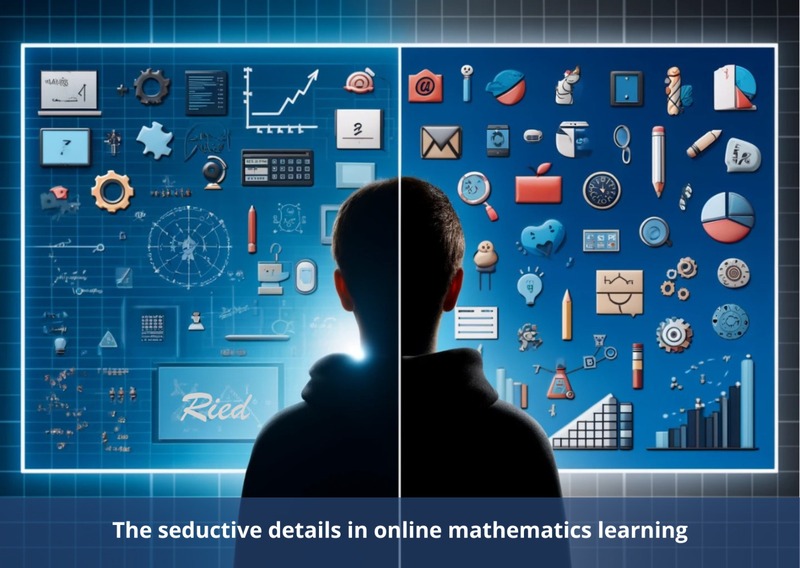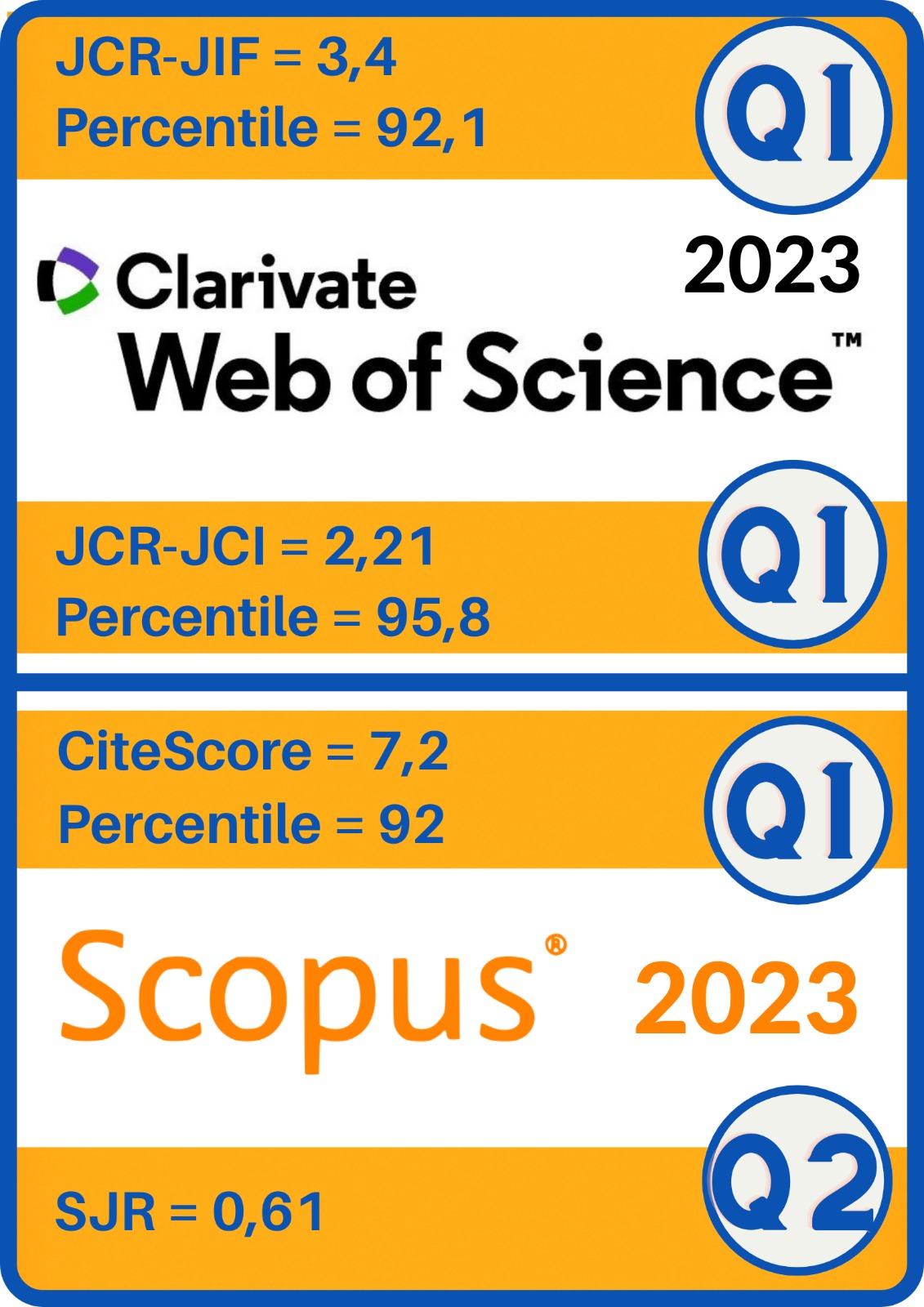Los detalles seductores en el aprendizaje en línea de matemáticas
DOI:
https://doi.org/10.5944/ried.27.2.38772Palabras clave:
aprendizaje asistido por ordenador, sistema multimedia, aprendizaje del dominio, capacidad cognitiva, proceso de aprendizajeResumen
Las nuevas tecnologías y los formatos multimedia han dado lugar a ambientes virtuales sincrónicos de aprendizaje de matemáticas muy atractivos. No obstante, la teoría cognitiva del aprendizaje multimedia sugiere que es preferible eliminar la información seductora de una presentación multimedia. Sin embargo, aún no está claro si este efecto se manifiesta en situaciones ecológicas como las videoconferencias sincrónicas. Con el fin de abordar esta brecha, se llevaron a cabo dos experimentos para examinar el efecto de las imágenes instructivas, decorativas y seductoras en el aprendizaje de matemáticas mediante videoconferencias sincrónicas, tanto para estudiantes principiantes como avanzados. El primer experimento (n = 156) reveló que tanto los materiales con gráficos instructivos como los materiales sin gráficos son más eficientes (i.e., generan mayor desempeño con igual esfuerzo mental) que los materiales con gráficos seductores. En el segundo experimento, se analizó el papel moderador del conocimiento previo (n = 163), incluyendo estudiantes avanzados en el estudio. Los resultados sugirieron que los estudiantes principiantes obtuvieron un mejor desempeño con materiales que contenían gráficos instructivos y decorativos en comparación con aquellos que presentaban gráficos seductores. Sin embargo, esta desventaja de aprender con gráficos seductores desapareció en los estudiantes avanzados. Se concluye que la efectividad del aprendizaje en línea de matemáticas depende del tipo de gráfico utilizado y del nivel de conocimiento previo. Estos resultados se discuten desde la perspectiva de la carga cognitiva y del aprendizaje multimedia, y se proporcionan orientaciones prácticas para la enseñanza e investigación del aprendizaje en línea de las matemáticas.
Descargas
Citas
Bender, L., Renkl, A., & Eitel, A. (2021). When and how seductive details harm learning. A study using cued retrospective reporting. Applied Cognitive Psychology, 35(4), 948-959. https://doi.org/10.1002/acp.3822
Castro-Alonso, J. C., De Koning, B. B., Fiorella, L., & Paas, F. (2021). Five strategies for optimizing instructional materials: Instructor- and learner-managed cognitive load. Educational Psychology Review, 33(4), 1379-1407. https://doi.org/10.1007/s10648-021-09606-9
Chen, O., Woolcott, G., & Sweller, J. (2017). Using cognitive load theory to structure computer-based learning including MOOCs. Journal of Computer Assisted Learning, 33(4), 293-305. https://doi.org/10.1111/jcal.12188
Clark, R. C., & Mayer, R. E. (2024). e-Learning and the science of Instruction: Proven guidelines for consumers and designers of multimedia learning (5th ed.). Wiley.
Downes, S. (2022). Newer theories for digital learning spaces. In Handbook of Open, Distance and Digital Education (pp. 1-18). Springer. https://doi.org/10.1007/978-981-19-0351-9_8-1
Field, A. (2024). Discovering Statistics Using IBM SPSS Statistics (6th ed.). SAGE.
Fiorella, L. (2023). Making sense of generative learning. Educational Psychology Review, 35(2). https://doi.org/10.1007/s10648-023-09769-7
Fiorella, L., & Mayer, R. E. (2021). Principles for reducing extraneous processing in multimedia learning: Coherence, signaling, redundancy, spatial contiguity, and temporal contiguity principles. In L. Fiorella & R. E. Mayer (Eds.), The Cambridge handbook of multimedia learning (3rd ed., pp. 185-198). Cambridge University Press. https://doi.org/10.1017/9781108894333.019
Forsberg, A., Guitard, D., Adams, E. J., Pattanakul, D., & Cowan, N. (2021). Children's long-term retention is directly constrained by their working memory capacity limitations. Developmental science, 25(2), Article e13164. https://doi.org/10.1111/desc.13164
Fries, L., DeCaro, M. S., & Ramirez, G. (2019). The lure of seductive details during lecture learning. Journal of Educational Psychology, 111(4), 736-749. https://doi.org/10.1037/edu0000301
Garner, R., Gillingham, M. G., & White, C. S. (1989). Effects of ‘seductive setails' on macroprocessing and microprocessing in adults and children. Cognition and Instruction, 6(1), 41-57. https://doi.org/10.1207/s1532690xci0601_2
Haleem, A., Javaid, M., Qadri, M. A., & Suman, R. (2022). Understanding the role of digital technologies in education: A review. Sustainable Operations and Computers, 3, 275-285. https://doi.org/10.1016/j.susoc.2022.05.004
Harp, S. F., & Mayer, R. E. (1997). The role of interest in learning from scientific text and illustrations: On the distinction between emotional interest and cognitive interest. Journal of Educational Psychology, 89(1), 92-102. https://doi.org/10.1037/0022-0663.89.1.92
Hoogerheide, V., Renkl, A., Fiorella, L., Paas, F., & Van Gog, T. (2019). Enhancing example-based learning: Teaching on video increases arousal and improves problem-solving performance. Journal of Educational Psychology, 111(1), 45-56. https://doi.org/10.1037/edu0000272
Jiang, D., Chen, O., Han, Y., & Kalyuga, S. (2023). Improving English language skills through learning Mathematic contents: From the expertise reversal effect perspective. British Journal of Educational Psychology, 93(S2), 386-401. https://doi.org/10.1111/bjep.12596
Kalyuga, S. (2021). The expertise reversal principle in multimedia learning. In R. E. Mayer & L. Fiorella (Eds.), The Cambridge handbook of multimedia learning (pp. 171-181). Cambridge University Press. https://doi.org/10.1017/9781108894333.017
Kalyuga, S., Ayres, P., Chandler, P., & Sweller, J. (2003). The expertise reversal effect. Educational Psychologist, 38(1), 23-31. https://doi.org/10.1207/S15326985EP3801_4
Kintsch, W. (1980). Learning from text, levels of comprehension, or: Why anyone would read a story anyway. Poetics, 9(1), 87-98. https://doi.org/10.1016/0304-422X(80)90013-3
Korbach, A., Brünken, R., & Park, B. (2016). Learner characteristics and information processing in multimedia learning: A moderated mediation of the seductive details effect. Learning and Individual Differences, 51, 59-68. https://doi.org/10.1016/j.lindif.2016.08.030
Lehmann, J. A. M., & Seufert, T. (2017). The influence of background music on learning in the light of different theoretical perspectives and the role of working memory capacity. Frontiers in Psychology, 8, 1902. https://doi.org/10.3389/fpsyg.2017.01902
Lindner, M. A. (2020). Representational and decorative pictures in science and mathematics tests: Do they make a difference? Learning and Instruction, 68, Article 101345. https://doi.org/10.1016/j.learninstruc.2020.101345
Magner, U. I. E., Schwonke, R., Aleven, V., Popescu, O., & Renkl, A. (2014). Triggering situational interest by decorative illustrations both fosters and hinders learning in computer-based learning environments. Learning and Instruction, 29, 141-152. https://doi.org/10.1016/j.learninstruc.2012.07.002
Mayer, R. E. (2012). Information processing. In K. R. Harris, S. Graham, T. Urdan, C. B. McCormick, G. M. Sinatra & J. Sweller (Eds.), APA educational psychology handbook: Theories, constructs, and critical issues (Vol. 1, pp. 85-99). American Psychological Association. https://doi.org/10.1037/13273-004
Mayer, R. E. (2019). Taking a new look at seductive details. Applied Cognitive Psychology, 33(1), 139-141. https://doi.org/10.1002/acp.3503
Mayer, R. E. (2020). Multimedia learning (3th ed.). Cambridge University Press. https://doi.org/10.1017/9781108894333.003
Mayer, R. E., & Estrella, G. (2014). Benefits of emotional design in multimedia instruction. Learning and Instruction, 33, 12-18. https://doi.org/10.1016/j.learninstruc.2014.02.004
Mayer, R. E., & Fiorella, L. (2022). The Cambridge handbook of multimedia learning (3th ed.). Cambridge University Press. https://doi.org/10.1017/9781108894333.003
Mayer, R. E., Griffith, E., Jurkowitz, I. T., & Rothman, D. (2008). Increased interestingness of extraneous details in a multimedia science presentation leads to decreased learning. Journal of Experimental Psychology: Applied, 14(4), 329-339. https://doi.org/10.1037/a0013835
Mayer, R. E., & Jackson, J. (2005). The case for coherence in scientific explanations: Quantitative details can hurt qualitative understanding. Journal of Experimental Psychology: Applied, 11(1), 13-18. https://doi.org/10.1037/1076-898X.11.1.13
Mikheeva, M., Schneider, S., Beege, M., & Rey, G. D. (2021). The influence of affective decorative pictures on learning statistics online. Human Behavior and Emerging Technologies, 3(3), 401-412. https://doi.org/10.1002/hbe2.250
Miralles Martínez, P., Gómez Carrasco, C. J., & Monteagudo Fernández, J. (2019). Percepciones sobre el uso de recursos TIC y «MASS-MEDIA» para la enseñanza de la historia. Un estudio comparativo en futuros docentes de España-Inglaterra. Educación XX1, 22(2). https://doi.org/10.5944/educxx1.21377
Moreno, R., & Mayer, R. E. (2000). A coherence effect in multimedia learning: The case for minimizing irrelevant sounds in the design of multimedia instructional messages. Journal of Educational Psychology, 92, 117-125. https://doi.org/10.1037/0022-0663.92.1.117
Nairne, J. S. (2022). Adaptive education: Learning and remembering with a stone-age brain. Educational Psychology Review, 34(4), 2275-2296. https://doi.org/10.1007/s10648-022-09696-z
Noetel, M., Griffith, S., Delaney, O., Harris, N. R., Sanders, T., Parker, P., del Pozo Cruz, B., & Lonsdale, C. (2021). Multimedia design for learning: An overview of reviews with meta-meta-analysis. Review of Educational Research, 90(1), 6–23. https://doi.org/10.3102/00346543211052329
Park, B., Moreno, R., Seufert, T., & Brünken, R. (2011). Does cognitive load moderate the seductive details effect? A multimedia study. Computers in Human Behavior, 27(1), 5-10. https://doi.org/10.1016/j.chb.2010.05.006
Park, S., Kim, M., Lee, Y., Son, C., & Lee, M. (2005). The effects of visual illustrations on learners' achievement and interest in PDA- (Personal Digital Assistant) based learning. Journal of Educational Computing Research, 33(2), 173-187. https://doi.org/10.2190/ELEY-NPQN-0WVM-FW0G
Plass, J. L., & Kalyuga, S. (2019). Four ways of considering emotion in cognitive load theory. Educational Psychology Review, 31(339-359). https://doi.org/10.1007/s10648-019-09473-5
Renninger, K. A., & Hidi, S. E. (2016). The power of interest for motivation and engagement. Routledge. https://doi.org/10.4324/9781315771045
Rey, G. D. (2012). A review of research and a meta-analysis of the seductive detail effect. Educational Research Review, 7(3), 216-237. https://doi.org/10.1016/j.edurev.2012.05.003
Rey, G. D. (2014). Seductive details and attention distraction – An eye tracker experiment. Computers in Human Behavior, 32, 133-144. https://doi.org/10.1016/j.chb.2013.11.017
Richter, J., Wehrle, A., & Scheiter, K. (2021). How the poor get richer: Signaling guides attention and fosters learning from text‐graph combinations for students with low, but not high prior knowledge. Applied Cognitive Psychology. https://doi.org/10.1002/acp.3786
Sadoski, M., & Paivio, A. (2013). Imagery and text: A dual coding theory of reading and writing. Routledge. https://doi.org/10.4324/9781410605276
Sanchez, C. A., & Wiley, J. (2006). An examination of the seductive details effect in terms of working memory capacity. Memory & Cognition, 34(2), 344-355. https://doi.org/10.3758/BF03193412
Schneider, S., Dyrna, J., Meier, L., Beege, M., & Rey, G. D. (2018). How affective charge and text–picture connectedness moderate the impact of decorative pictures on multimedia learning. Journal of Educational Psychology, 110(2), 233-249. https://doi.org/10.1037/edu0000209
Schneider, S., Wirzberger, M., & Rey, G. D. (2018). The moderating role of arousal on the seductive detail effect in a multimedia learning setting. Applied Cognitive Psychology. https://doi.org/10.1002/acp.3473
Skulmowski, A. (2023). Guidelines for Choosing Cognitive Load Measures in Perceptually Rich Environments. Mind, Brain, and Education, 17(1), 20-28. https://doi.org/10.1111/mbe.12342
Stark, L., Brünken, R., & Park, B. (2018). Emotional text design in multimedia learning: A mixed-methods study using eye tracking. Computers & Education, 120, 185-196. https://doi.org/10.1016/j.compedu.2018.02.003
Sundararajan, N., & Adesope, O. (2020). Keep it coherent: A meta-analysis of the seductive details effect. Educational Psychology Review. https://doi.org/10.1007/s10648-020-09522-4
Sung, E., & Mayer, R. E. (2012). When graphics improve liking but not learning from online lessons. Computers in Human Behavior, 28(5), 1618-1625. https://doi.org/10.1016/j.chb.2012.03.026
Sweller, J. (2024). Cognitive load theory and individual differences. Learning and Individual Differences, 110. https://doi.org/10.1016/j.lindif.2024.102423
Tricot, A., & Sweller, J. (2014). Domain-specific knowledge and why teaching generic skills does not work. Educational Psychology Review, 26(2), 265-283. https://doi.org/10.1007/s10648-013-9243-1
Van Gog, T., & Paas, F. (2008). Instructional efficiency: Revisiting the original construct in educational research. Educational Psychologist, 43(1), 16-26. https://doi.org/10.1080/00461520701756248
Wang, Z., & Adesope, O. (2016). Does learners’ prior knowledge moderate the detrimental effects of seductive details in reading from text? A 2 by 3 study. International Journal of Instruction, 9(2), 35-50. https://doi.org/10.12973/iji.2016.923a
Zambrano R., J., Kirschner, F., Sweller, J., & Kirschner, P. A. (2019). Effects of prior knowledge on collaborative and individual learning. Learning and Instruction, 63, Article 101214. https://doi.org/10.1016/j.learninstruc.2019.05.011









